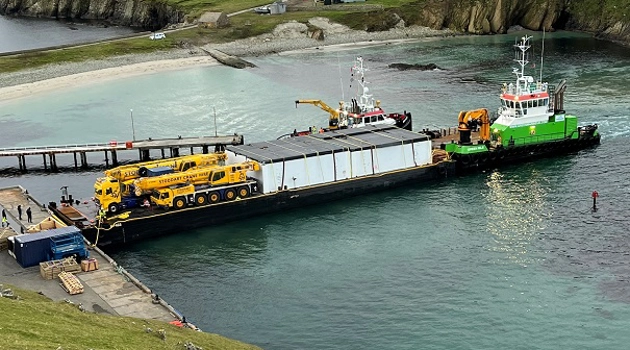
The project, which is led by Fair Isle Bird Observatory Trust (FIBOT), will create seven new green jobs, help sustain the island’s population and meet the community’s aspirations to become carbon neutral by 2040.
Highlands and Islands Enterprise (HIE) and Scottish Government are supporting the development with a funding package totalling £2.35m.
The energy efficient building will use power from the island’s community-owned renewable energy grid as well as from the building’s own solar panels.
The innovative modular building was designed by Colin Armstrong Architects, based in Inverness. They were constructed off-site by IDHM in a factory in Sheffield, before being taken by lorry to Grimsby. From there they sailed to Kirkwall on a barge and from Kirkwall to Fair Isle and the first barge arrived on the island on 19 October for assembly and completion works.
Following their arrival in Fair Isle, contractors IDMH will put the modules together before installing the roof and the cladding.
The observatory was first established in 1948 and has played a vital role in sustaining the population of Fair Isle, which is located roughly halfway between Orkney and Shetland and currently has a population of around 50.
The new premises will include 29 high quality guest rooms for visitors and staff with social space and facilities for research. This will occupy the site of the most recent building, which was completed in 2011 but destroyed in a disastrous fire in March 2019.
As well as being a popular visitor attraction for bird watchers, the observatory has had an important research role, gathering bird census and migration data for the past 70 years
Katrina Wiseman, area manager for HIE’s Shetland area team, said:
“Fair Isle can now look forward to a promising future as a global eco-tourism destination. The Observatory plays a crucial role in supporting the viability and sustainability of one of the most remote islands in the UK.”
“The project is bringing back a key income generating facility, providing employment, hosting visitors to the Island, and providing world renowned research. This will provide significant spin-off benefits for all island businesses as well as the community.”
“The facility also addresses other challenges for Fair Isle such as retaining and attracting population, and the need for tourism to be more sustainable. We are very much looking forward to seeing the observatory open once again.”
The observatory has close links to other organisations such as the National Trust for Scotland which owns the remainder of the island.
Douglas Barr, Chair of FIBOT, said:
“I am delighted to see the factory built modules arriving in Fair Isle and the start of the new bird observatory. This will allow us to continue and develop further our world class data and research and for us to maintain our important role in both the tourist and wider Fair Isle economy. We really look forward to being open again and welcoming visitors to the island.”

